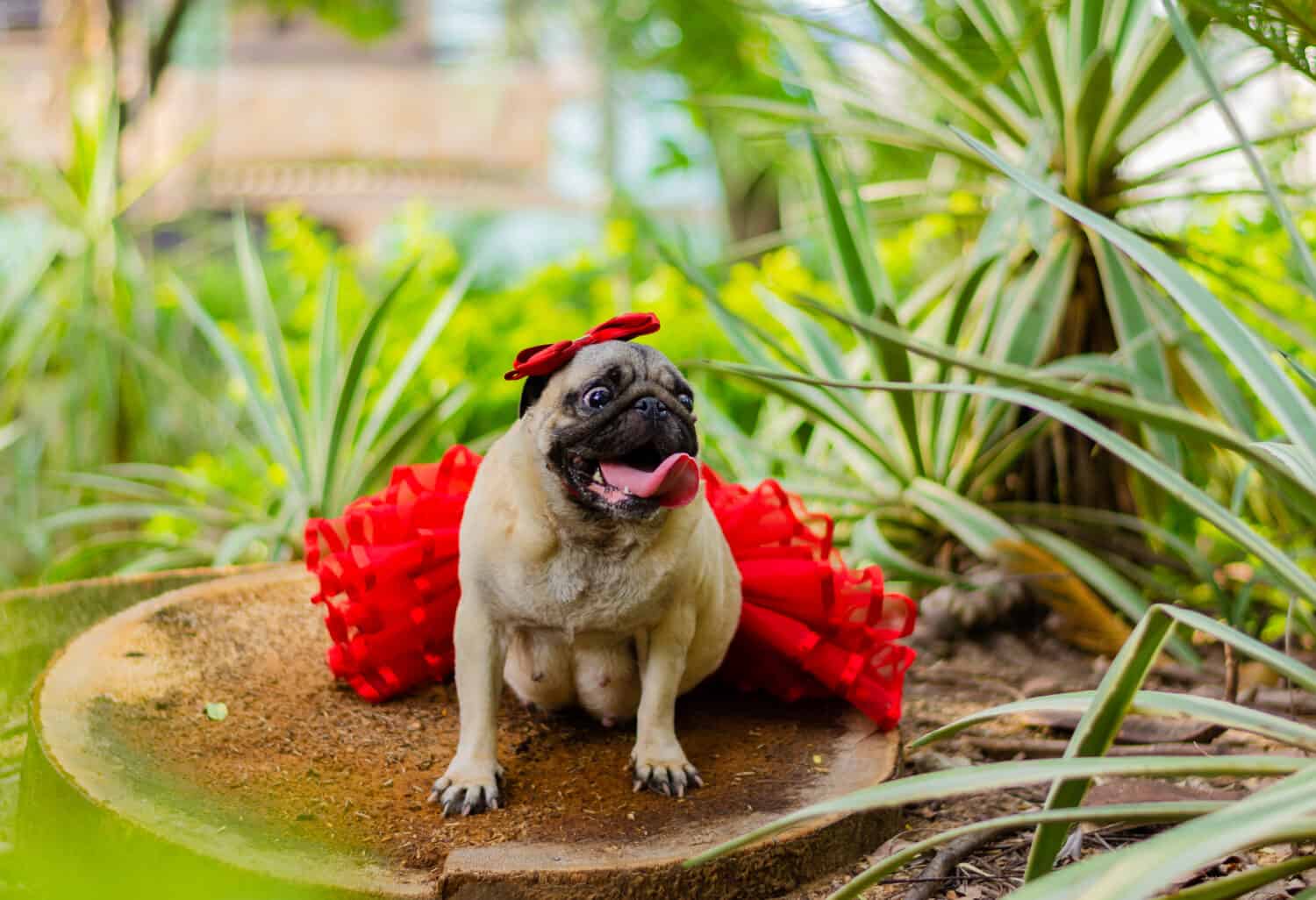Pug pregnancy can be exciting for any pug owner, but being prepared is essential. In this guide, we will walk through everything you need to know about pug pregnancy, from pregnancy symptoms, gestation period, pregnancy care, litter size, weekly milestones, preparing for labor, and aftercare. Being informed about what to expect during your pug’s pregnancy will help ensure the health and well-being of both momma and puppies.

Pugs may show signs of pregnancy around 3-4 weeks.
©iStock.com/adogslifephoto
Pregnancy Symptoms
The first signs of pregnancy may be subtle. Around 3-4 weeks into pregnancy, your pug may exhibit the following:
- Decreased appetite
- Increased tiredness
- Weight gain
- Enlarged or swollen nipples
- More affectionate behavior
- As pregnancy progresses, symptoms will become more noticeable by 5-6 weeks. These include:
- Abdominal swelling
- Nesting behaviors like gathering blankets or toys
- Milky discharge from nipples
- Vomiting
Watch for these symptoms if you suspect your pug may be pregnant. Consult with your veterinarian if you notice any concerning changes.
Gestation Period: How Long Are Pugs Pregnant?
The typical gestation period for pugs is around 63 days or nine weeks. This is longer for dogs, as smaller breeds tend to have slightly longer pregnancies.
Pregnancy can only be confirmed by an ultrasound scan by your vet around 3-4 weeks into gestation when the fetuses can be visualized. Track your pug’s assumed conception date if you believe she may be pregnant, so you can monitor her gestation timeline and plan accordingly.

Make sure your pug is as comfortable as possible during her pregnancy.
©Alex_Zh/Shutterstock.com
Pregnancy Care for Pugs
Providing attentive care for your expecting pug is essential to support her health and that of the puppies. Here are some tips:
Feeding
Up her food intake by 10-25% during pregnancy and transition to high-quality puppy food in the final third of pregnancy to support the growing puppies’ nutritional needs. Feeding smaller, more frequent meals may make it easier on your pug.
Vet visits
Take your pug for regular veterinary check-ups throughout her pregnancy to monitor mom and puppies’ progress. Ultrasounds and heartbeat checks can identify any issues.
Exercise
Take your pug for shorter, more frequent walks to get fresh air and gentle exercise without overexertion. Additionally, be sure to avoid strenuous play or jumping.
Comfort
Offer your pug pillows, blankets, and a comfortable dog bed to nest in. Rubbing her belly, back massages, and gentle tummy scratches can also relax her. A dog pregnancy can be hard on your dog’s body, much like a human. This means you should do your best to comfort her at every stage.
Socialization
Spend time together brushing, petting, or offering praise and affection. Pregnancy hormones can cause behavioral changes, so positive interactions are essential.
Providing attentive pregnancy care will help keep your pug as comfortable and stress-free as possible as she prepares to welcome her puppies. Don’t hesitate to call your vet with any concerns.
Average Litter Size for Pugs
The average litter size for pugs is 4-6 puppies, though litters as small as one puppy or large as 9 are not uncommon. Litter size depends on factors like the size of the mother dog, her health, genetics, and whether it’s her first or subsequent litter.
As pugs have relatively small litter, it’s essential to monitor mom and puppies closely should any issues arise during pregnancy or delivery. Close supervision and an attentive pug owner can help identify problems early.

It’s important to know what to expect weekly during your pug’s pregnancy.
©apv76rj/Shutterstock.com
What to Expect Weekly
What to Expect in Week 1
Changes in Mom: At one week pregnant, your pug likely won’t show any outward signs of pregnancy yet. She may exhibit subtle behavior changes like decreased activity levels or less appetite as her progesterone levels rise.
Development of Puppies: The puppies have just been conceived but are not yet attached to the uterine lining. Cell division and rapid embryo development are taking place.
Care Tips: Schedule a vet visit for an ultrasound scan around 3-4 weeks to confirm pregnancy if you haven’t already. Begin tracking your pug’s gestation timeline and make notes on any diet, activity, or behavior changes.
What to Expect in Week 2
Changes in Mom: Your pug will still not show obvious pregnancy signs this week. Her energy levels may continue decreasing as her body focuses resources on the developing embryos.
Development of Puppies: The embryos migrate to the uterine horns and begin embedding into the lining this week. Placentas are starting to form to deliver nutrients to the fetuses.
Care Tips: Ensure your pug gets ample rest and starts transitioning her to high-quality puppy food. Contact your vet with concerns about decreased appetite, lethargy, or other symptoms.
What to Expect in Week 3
Changes in Mom: Around three weeks, you may notice swelling of your pug’s nipples and mammary glands as they prepare for lactation. Her abdomen may begin enlarging.
Development of Puppies: The embryos should be detectable on ultrasound as they grow rapidly, with visible heartbeats. Their bones, organs, and nervous systems are forming.
Care Tips: Take your pug for an ultrasound to verify pregnancy and determine how many puppies to expect. Also, ask your vet questions about proper care and nutrition during pregnancy.
What to Expect in Week 4
Changes in Mom: Your pug’s abdomen will become noticeably enlarged this week. Increased fatigue, mood changes, and sporadic vomiting are common pregnancy symptoms.
Development of Puppies: The puppies now look more like little dogs with their distinct body parts formed. Their faces take shape, and their eyelids develop.
Care Tips: Feed small, frequent meals as nausea develops. Supplement bland foods like boiled chicken and rice if your pug won’t eat her regular food. You should also spend quality time socializing and providing affection.
What to Expect in Week 5
Changes in Mom: Your pug’s weight gain will become more noticeable. Nesting behaviors like shredding paper or gathering blankets may begin. Mammary glands enlarge further.
Development of Puppies: Claws, toes, and skeletal systems continue developing, and puppies will be very active in the womb. Their organs, nerves, and muscles grow rapidly.
Care Tips: Increase food intake by 25% to meet growing nutritional needs. Provide comfortable nesting areas and soothing massages. Limit exercise to short walks.
What to Expect in Week 6
Changes in Mom: Your pug will appear heavily pregnant now. Milk discharge from nipples may occur. She may seem restless and exhibit nesting behaviors more frequently.
Development of Puppies: The puppies’ coat colors come in as their fur grows. They also begin to put on weight quickly, and their skeletons harden.
Care Tips: Add extra pillows and blankets to her nesting areas. Stick to routine potty breaks and short walks. Monitor for decreasing appetite, vomiting, or signs of labor approaching.
What to Expect in Week 7
Changes in Mom: Your pug’s abdomen will be significantly enlarged now. Mammary glands will enlarge further, and milk production will ramp up. Her temperature may drop slightly.
Development of Puppies: Puppies are rapidly gaining weight as fat stores develop. Their eyes also open, and hearing develops. They are readying for life outside the womb.
Care Tips: Up puppy food intake again and opt for moist foods if your pug has trouble eating. Limit exercise to very short bathroom breaks. Also, check her temperature daily now for drops indicating impending labor.
What to Expect in Week 8
Changes in Mom: Your pug may become more restless and anxious as her due date approaches. She will seek solitude and may lose her appetite entirely at this stage.
Development of Puppies: Puppies are now fully developed, with their organs and senses functional. They continue gaining weight rapidly in preparation for birth.
Care Tips: Ensure nesting areas are prepared with extra bedding and secluded areas. Check your pug’s temperature multiple times daily for significant drops. You should also have an emergency puppy kit prepared.
What to Expect in Week 9
Changes in Mom: Your pug is ready to give birth any day. Clear vaginal discharge may occur, appetite diminishes, and mammary glands may leak milk. Her temperature will drop below 100°F within 24 hours of labor starting.
Development of Puppies: Puppies are now ready for birth, with their heads towards the birth canal. They will be very active before delivery.
Care Tips: Monitor temperature diligently and watch for signs of early labor like pacing, panting, shivering, and nesting. Alert your vet once labor begins in case intervention is needed for any puppy or mom.

Preparation is key for smoother labor and delivery.
©Ezzolo/Shutterstock.com
How to Prepare for Labor and Delivery
Preparing for your pug’s labor and delivery is essential to help ensure a smooth process and healthy puppies. Here are some tips:
- Track temperature changes to identify when labor will start.
- Have an emergency contact number for your vet.
- Prepare a whelping box in a quiet area with bedding and heating pads.
- Gather supplies like towels, scissors, suction bulbs, and thermometer.
- Keep emergency puppy formula and bottles on hand.
- Familiarize yourself with stages of labor so you can time contractions.
- Monitor mom for any signs of distress and contact the vet if concerned.
- Weigh puppies immediately and document them for health tracking.
- Make sure each pup nurses shortly after birth.
Don’t hesitate to call your veterinarian if your pug encounters any difficulties with delivery – prompt assistance for troubled births can be crucial for positive outcomes. You can confidently navigate your pug’s pregnancy and delivery with preparation and vigilance.
How to Care For Your Pug After Giving Birth
Caring for your pug correctly after giving birth is vital to support her recovery and ability to nurse her puppies. Here are some post-whelping tips:
- Allow your pug to rest and limit disturbances to the whelping area.
- Provide high-calorie nutritional food to support nursing.
- Check that your pug is urinating and defecating normally.
- Monitor for excessive bleeding, discharge, fever, or signs of infection.
- Clean whelping area and replace bedding when soiled
- Weigh puppies daily to ensure they are gaining weight.
- Administer deworming medication to mom and puppies once advised
- Limit visitors to avoid stress during the first couple of weeks
- Watch for signs of postpartum depression, like lethargy or reduced nursing.
- Schedule a post-whelping vet visit for mom within 1-2 days of birth.
Caring for a new pug mom and her puppies is a big responsibility. Don’t be afraid to lean on your veterinarian for support and guidance during this exciting time. With attentive and informed care, you can keep mom and babies happy and healthy.
Conclusion
Pug pregnancy can be a fantastic experience as you eagerly await the arrival of adorable new puppies. By understanding pug gestation timelines, pregnancy symptoms, litter expectations, and week-by-week fetal development, you can provide attentive care for your expecting pug. Preparing correctly for the birth and knowing about aftercare will get the mom and puppies off to a great start. With some guidance from your veterinarian, you’ll be thoroughly equipped for the exciting journey of your pug’s pregnancy and birth!
The photo featured at the top of this post is © Ezzolo/Shutterstock.com
Ready to discover the top 10 cutest dog breeds in the entire world?
How about the fastest dogs, the largest dogs and those that are -- quite frankly -- just the kindest dogs on the planet? Each day, AZ Animals sends out lists just like this to our thousands of email subscribers. And the best part? It's FREE. Join today by entering your email below.
Thank you for reading! Have some feedback for us? Contact the AZ Animals editorial team.






